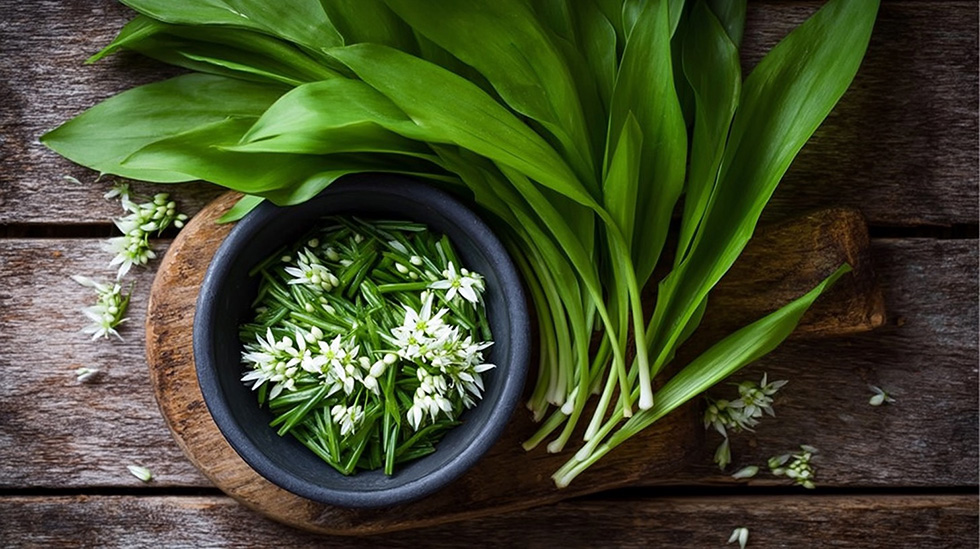Wild garlic – The Green Gold of Forests
One of the most exciting heralds of spring is the wild garlic, also known as ramsons. The Latin name is Allium ursinum, from which the word “ursinum” refers to bears – legend has it that bears waking up from their dens start their spring feeding with it, hence the name. It is a plant that is widespread throughout Europe and has been known since ancient times, but in recent years it has once again become a star in the kitchen. 🌿

How important is it in the kitchen?
4/5 – Although seasonal and a quickly fading delicacy, it is an indispensable refreshing ingredient in spring Hungarian and Central European cuisine. A good scones or cream soup with wild garlic is a must in spring! Less known in Mediterranean countries, it has a real cult following in Central Europe.
Which part is edible?
The fresh, green leaves of the wild garlic are what we eat, usually from late March to mid-May. The leaves are at their best when tender, so it’s best to get them early in the season. After flowering (when the white flowers appear), the leaves change flavour and become slightly bitter, making them less suitable for culinary use.
Important! The bulb is also edible, but it is forbidden to collect it by root from protected areas in Hungary. The leaves can easily be mistaken for the leaves of lily of the valley or autumn chickweed, which are poisonous, so always choose bear’s onions from a safe source!
Health benefits
Wild garlic is a superstar when it comes to health:
- Rich in vitamin C, iron, magnesium and manganese
- Antibacterial and antifungal action
- Helps fight spring fatigue
- Purifies the blood and supports liver function
- Can lower blood pressure and cholesterol
It has been used in folk medicine for centuries to treat various digestive complaints, bloating, intestinal distress and rheumatic problems.
Growing, season, availability
Wild garlic grows wild in the undergrowth of shady, damp forests, mainly in Central and Eastern Europe. In Hungary, it is found in large numbers in the Mecsek, Zselic and Bakony regions. It is an open field, not a greenhouse plant, so it is grown only seasonally.
The season runs from the end of March to mid-May, depending on how early spring arrives. You can find it in most domestic shops in April. Imported products are rare because they lose their freshness quickly and are difficult to store for long periods.
How to choose good quality wild garlic
Look for fresh, tender leaves that:
- Bright green colour
- Not wilted, not yellowish
- No edge tearing
- Garlicky smell, but not too strong
If the leaves are too thick and strongly scented, they are probably too old to be a culinary delight.
How to store it at home?
Wild garlic wilt quickly, so it’s best to use them within 1-2 days. Wrap in slightly damp kitchen paper and refrigerate for 3-4 days to keep fresh. Alternatively, you can freeze it chopped and mixed with olive oil in an ice cube tray – so you’ll have a spoonful of this green wonder on hand all year round. 😉
International outlook
Wild garlic is mainly popular in Central Europe, for example in Germany it is known as Bärlauch, where it is served in cream soups, pesto or butter. Less well known in the Anglo-Saxon world, it is known as “wild garlic”. In France it is used as ‘ail des ours’, mostly in salads and sauces.
Recipe: Hungarian savory pastry with wild garlic
Ingredients:
- 50 dkg flour
- 25 dkg butter or margarine
- 1 packet baking powder
- 2 dl sour cream
- 1 egg
- 1 bunch fresh bear’s onion, finely chopped
- salt to taste
Preparation: knead the ingredients, leave to rest for half an hour, then roll out and cut out. Bake at 180°C for about 20 minutes until golden brown. Perfect as a guest dessert, breakfast or snack!
Kitchen tips and tricks
Wild garlic is best used fresh, as heat can reduce its flavour. It is an excellent match:
- for egg dishes (scrambled eggs, omelettes)
- for pasta, gnocchi
- for soups, stews
- for fresh cheese spreads, dips
- for homemade pesto – with pine nuts, parmesan, olive oil
Spices that go well with it: pepper, nutmeg, lemon zest, parsley.
What to avoid: spices that are too characterful, such as rosemary or cumin, as they can overpower the delicate garlicky character of the onion.
If you’ve been browsing the market, now is the time to try it – there’s a reason why wild garlic is the green sensation of the spring! 🌱
